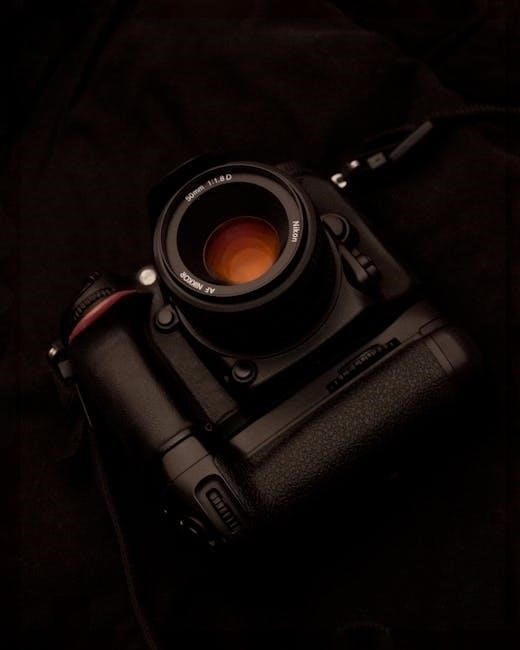
manual for nikon d3100
The Nikon D3100 manual is your gateway to unlocking the camera’s full potential, offering detailed guidance on features like the 14․2 MP sensor, EXPEED 2 engine, and HD video recording․ Designed for both beginners and advanced photographers, it provides step-by-step instructions to master settings, shooting modes, and troubleshooting, ensuring optimal performance and creative control․
1․1 Overview of the Nikon D3100 Camera
The Nikon D3100 is an entry-level DSLR camera designed for beginners and hobbyists, featuring a 14․2 MP DX-format APS CMOS sensor and the EXPEED 2 image processing engine․ It offers an 11-point autofocus system, full HD video recording at 1080p, and a user-friendly interface․ The camera is compact, lightweight, and equipped with Guide Mode to assist new users․ Its specifications and features make it an excellent choice for capturing high-quality images and videos, supported by a comprehensive manual for optimal usage․
1․2 Importance of the Manual for Optimal Camera Usage
The Nikon D3100 manual is essential for understanding and utilizing the camera’s features effectively․ It provides detailed explanations of settings, shooting modes, and troubleshooting, ensuring users can harness the camera’s full potential․ From mastering aperture and shutter speed to navigating the menu system, the manual acts as a comprehensive guide․ It empowers photographers to move beyond automatic modes, explore creative possibilities, and achieve professional-quality results, making it an indispensable resource for both beginners and experienced photographers alike․

Key Features of the Nikon D3100
The Nikon D3100 boasts a 14․2 MP DX-format APS-CMOS sensor, EXPEED 2 image processor, 11-point autofocus, and full HD 1080p video recording at 24fps, delivering crisp, vibrant results․
2․1 14․2 MP DX-Format APS CMOS Sensor
The Nikon D3100 features a 14․2 MP DX-format APS-CMOS sensor, delivering crisp, high-resolution images with vivid colors․ Its compact size and advanced design ensure excellent image clarity, even in low-light conditions, while minimizing noise․ This sensor is the heart of the camera, providing the foundation for capturing stunning photos with precise detail and dynamic range, making it ideal for both everyday shooting and creative photography projects․
2․2 EXPEED 2 Image Processing Engine
The Nikon D3100 is equipped with the EXPEED 2 image processing engine, which enhances image quality by optimizing sensor data․ It improves noise reduction, color accuracy, and overall processing speed, ensuring sharp and vibrant images․ The EXPEED 2 also supports advanced features like full HD video recording and fast autofocus, making it a crucial component for both still photography and video capture, delivering consistent and reliable performance across various shooting conditions․
2․3 11-Point Autofocus System
The Nikon D3100 features an 11-point autofocus system designed for quick and precise focus acquisition․ This system includes a cross-type center sensor for enhanced accuracy and speed, ensuring sharp images even in challenging lighting conditions․ The AF points cover a wide area, allowing for flexible subject tracking and composing․ Users can select specific AF points manually or rely on the camera’s automatic selection, making it versatile for various shooting scenarios, from portraits to dynamic action shots, with reliable performance․
2․4 Full HD Video Recording (1080p at 24fps)
The Nikon D3100 supports full HD video recording at 1080p resolution with a frame rate of 24fps, delivering a cinematic feel to your footage․ This feature makes it an excellent choice for videographers and photographers alike․ The manual exposure control allows for creative adjustments during filming, while the camera’s compact design ensures portability․ However, it lacks continuous autofocus during video recording, requiring manual focus adjustments․ Despite this, the D3100’s HD video capabilities remain impressive for its class, producing high-quality, detailed videos with vibrant colors․
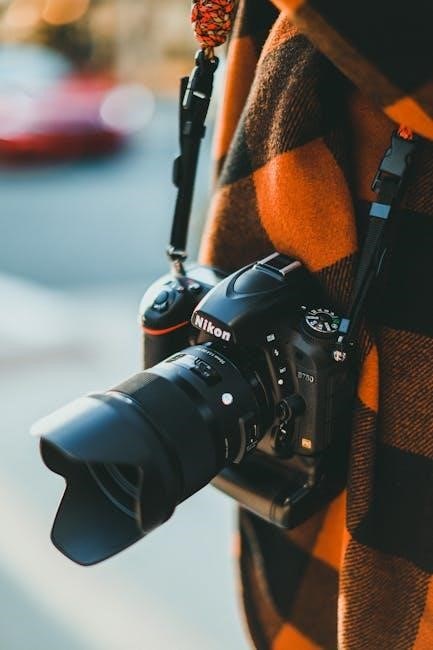
Getting Started with the Nikon D3100
Unboxing, initial setup, and basic camera overview are essential first steps․ Familiarize yourself with the camera body, lenses, and accessories to ensure a smooth start with your D3100․
3․1 Unboxing and Initial Setup
Begin by carefully unboxing your Nikon D3100, ensuring all accessories like the battery, charger, and lens are included․ Inspect the camera body for any damage․ Charge the battery fully before first use․ Insert the battery into the camera and mount the supplied lens or your preferred accessory․ Power on the camera and navigate through the initial setup menu to set language, time, and date․ Familiarize yourself with the camera’s layout and basic controls to prepare for your first shoot․ Proper setup ensures a seamless start with your D3100․
3․2 Mounting Lenses and Accessories
Mounting lenses and accessories on your Nikon D3100 is straightforward․ Align the lens mount index on the camera with the white dot on the lens, then twist to secure․ Ensure the lens clicks into place for proper mounting․ For accessories like flashes or grips, attach them to the hot shoe or accessory terminals․ Always use Nikon-compatible accessories to avoid damage․ The manual provides detailed guidance on compatible lenses and proper mounting techniques to prevent damage and ensure optimal performance․
3․3 Basic Camera Body Overview
The Nikon D3100 features a compact and lightweight body with intuitive controls․ The 3-inch LCD screen provides clear image review and menu navigation․ The optical viewfinder offers precise composition, while the mode dial simplifies switching between shooting modes․ The camera includes a built-in flash and hot shoe for external accessories․ The body houses the 14․2 MP APS-C sensor and EXPEED 2 engine, ensuring high-quality images․ The manual guides users through understanding and utilizing these components effectively for optimal performance and creativity․
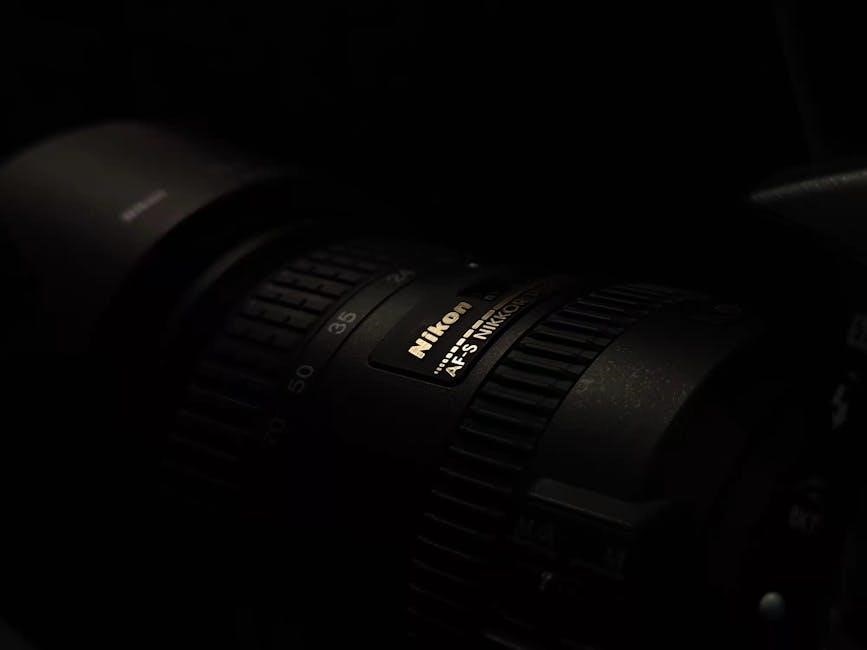
Understanding the Nikon D3100 Menu System
The Nikon D3100 menu system is user-friendly, allowing easy navigation through shooting settings, playback options, and customization․ The guide mode assists beginners, while advanced users can refine settings for precise control․
4․1 Navigating the Menu Structure
Navigating the Nikon D3100 menu system is straightforward, with options organized into logical categories․ Use the multi-selector to scroll through settings like shooting modes, image quality, and autofocus․ The menu is divided into sections such as Playback, Shooting, and Setup, making it easy to locate specific functions․ Customization options allow users to tailor settings to their preferences, enhancing the camera’s flexibility and user experience;
4․2 Customizing Settings for Personalized Use
The Nikon D3100 allows users to customize settings to suit their preferences, enhancing the shooting experience․ Personalize options like button assignments, shooting modes, and display settings to streamline your workflow․ The menu provides flexibility to tailor functions such as autofocus, ISO sensitivity, and white balance, ensuring a personalized setup․ This customization empowers photographers to optimize the camera for their unique style and shooting conditions, making it an indispensable tool for creative control and efficiency․
4․3 Utilizing the Guide Mode for Beginners
The Nikon D3100’s Guide Mode is an invaluable tool for new photographers, offering step-by-step assistance to capture stunning images․ This intuitive feature simplifies complex settings by guiding users through options like aperture, shutter speed, and ISO․ It provides clear explanations and visual aids, helping beginners understand how to achieve desired effects, such as blurred backgrounds or freeze motion․ The Guide Mode acts as a built-in tutor, making it easier to learn and experiment with different techniques, fostering creativity and confidence in photography skills․

Shooting Modes on the Nikon D3100
The Nikon D3100 offers versatile shooting modes, including Auto, Scene, Aperture Priority, Shutter Priority, and Manual․ These modes cater to different skill levels and creative goals, providing flexibility for capturing stunning images in various conditions․
- Auto Mode: Simplifies photography for beginners․
- Scene Modes: Optimizes settings for specific scenarios like portraits or landscapes․
- Aperture/Shutter Priority: Offers partial manual control for creative adjustments․
- Manual Mode: Provides full control for advanced photographers․
5․1 Auto Mode and Scene Modes
The Nikon D3100 features Auto Mode for effortless photography, automatically adjusting settings for optimal results․ Scene Modes further enhance creativity by tailoring camera settings to specific scenarios like Portrait, Landscape, and Close-Up․ These modes simplify photography for beginners, ensuring sharp focus and balanced exposure without manual adjustments․ With Auto and Scene Modes, users can capture stunning images in various conditions, leveraging the camera’s intelligent automation for stress-free shooting experiences․
5․2 Aperture Priority and Shutter Priority Modes
Aperture Priority (A/Av mode) lets you control the aperture, while the camera adjusts the shutter speed for proper exposure․ Ideal for depth-of-field control, it’s perfect for portraits or landscapes․ Shutter Priority (S/Tv mode) allows you to set the shutter speed, great for freezing or blurring motion, while the camera manages the aperture․ Both modes offer creative flexibility, enabling photographers to balance exposure while emphasizing specific artistic effects, making them versatile tools for enhancing image capture․
5․3 Manual Mode for Advanced Control
Manual Mode (M) offers full control over aperture, shutter speed, and ISO, allowing photographers to tailor settings for precise creative results․ This mode is ideal for experienced users seeking ultimate control․ Adjustments can be made using the aperture and shutter speed dials, while ISO settings are accessed via the menu․ The exposure compensation button fine-tunes brightness, ensuring optimal results․ Use the histogram for precise exposure assessment․ Mastering Manual Mode unlocks the full creative potential of the Nikon D3100, enabling photographers to achieve their artistic vision․

Mastering Exposure on the Nikon D3100
Mastery of exposure involves balancing aperture, shutter speed, and ISO to achieve desired results․ The manual explains how to control these elements for optimal image quality and artistic expression;
6․1 Understanding Aperture and Its Effects
Aperture refers to the camera’s iris opening, controlling light intake and depth of field․ The Nikon D3100 manual explains aperture settings (f-stops), where lower values (f/2․8) create shallow focus and higher values (f/16) ensure more of the image is sharp․ Mastering aperture allows photographers to isolate subjects or capture landscapes with clarity, balancing creativity with technical precision for stunning results․
6․2 Controlling Shutter Speed for Creative Effects
Shutter speed determines how long the camera’s shutter remains open, influencing motion and focus․ The Nikon D3100 manual highlights its creative impact, allowing photographers to freeze fast-moving subjects with short speeds (1/1000th of a second) or create artistic blur with longer exposures (seconds or minutes)․ Balancing shutter speed with aperture and ISO is key for achieving desired effects, from sharp action shots to silky waterfalls, empowering photographers to experiment with time and motion creatively․
6․3 Managing ISO for Optimal Image Quality
ISO sensitivity regulates the camera’s light capture, balancing exposure and noise․ The Nikon D3100 manual explains that lower ISOs (100-400) deliver sharp, detailed images with minimal noise, ideal for bright conditions․ Higher ISOs (6400 and above) are suited for low-light scenarios but may introduce grain․ The camera’s Auto ISO feature simplifies adjustments, while manual control allows photographers to prioritize image quality or noise reduction, ensuring optimal results in various lighting environments․

Focusing Techniques with the Nikon D3100
The Nikon D3100 offers an 11-point autofocus system for quick, precise focus acquisition and manual focus mode for fine-tuned control, ensuring sharp images in diverse shooting scenarios․
7․1 Using Autofocus Effectively
The Nikon D3100’s 11-point autofocus system delivers fast and precise focus acquisition, ideal for capturing sharp images in dynamic situations․ For moving subjects, use AF-C mode to continuously track motion, while AF-S mode is best for stationary objects․ The manual explains how to select focus points manually for greater control, ensuring sharpness where it matters most․ By mastering these autofocus techniques, you can achieve professional-grade results with ease and confidence․
7․2 Mastering Manual Focus for Precision
Manual focus on the Nikon D3100 allows for precise control over your images, especially in situations where autofocus may struggle, such as low light or macro photography․ The manual explains how to engage manual focus mode, either through the lens or camera settings․ By using the camera’s focus indicators and the LCD screen, you can achieve razor-sharp results․ Techniques like focus peaking or magnifying the preview ensure accuracy, giving you complete creative control over your compositions․
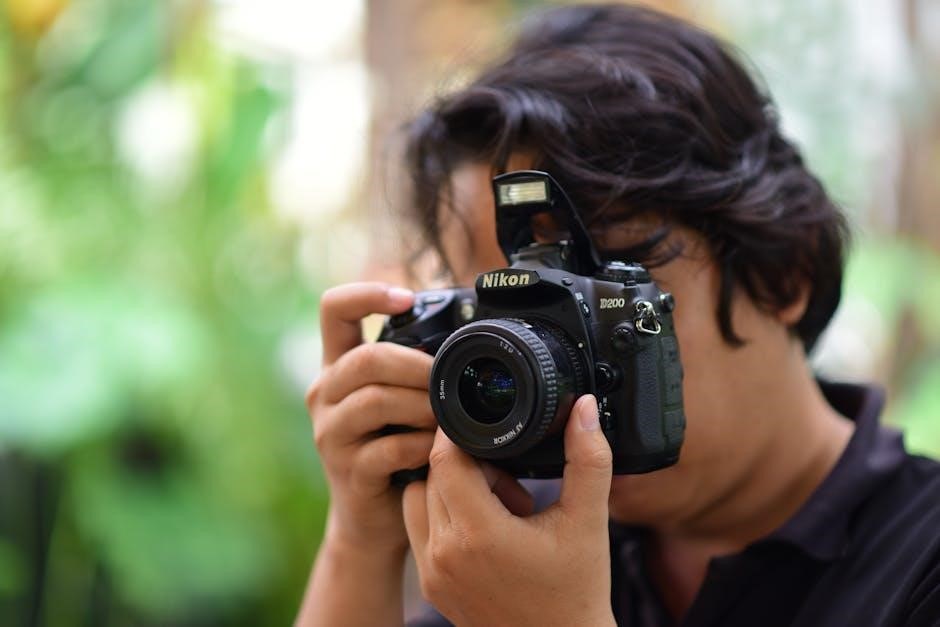
Image Review and Management
The Nikon D3100 allows you to review images on its LCD screen, analyze histograms for exposure accuracy, and efficiently manage files by deleting or protecting them․
8․1 Playback and Image Review Features
The Nikon D3100 features a robust playback system, allowing you to review images on its 3-inch LCD screen․ Zoom in on details with the playback zoom function to check focus and sharpness․ Histograms are displayed to assess exposure accuracy, ensuring properly balanced lighting․ You can also view images in a slideshow format for a quick overview of your shots․ Additionally, the camera offers options to delete unwanted photos, protect favorites, and rotate images for optimal viewing․ These tools streamline image management and enhance your post-capture workflow․
8․2 Using Histograms for Exposure Assessment
The Nikon D3100’s histogram feature provides a visual representation of image brightness and shadow detail, helping you assess exposure accuracy․ Accessed during playback, the histogram displays tonal distribution, allowing you to identify overexposed or underexposed areas․ This tool enables precise adjustments to aperture, shutter speed, and ISO for balanced lighting․ By analyzing the histogram, you can ensure optimal exposure, minimizing the need for post-processing corrections and enhancing overall image quality․ Regular use of this feature improves your ability to capture well-exposed shots consistently․
8․3 Deleting and Protecting Images
The Nikon D3100 allows you to manage your images efficiently by deleting unwanted photos or protecting important ones․ During playback, you can delete single images or multiple files at once using the camera’s menu․ Protecting images prevents accidental deletion, ensuring your favorite shots remain safe․ This feature is accessed through the playback menu, where you can mark images as protected․ Regularly reviewing and managing your images helps maintain organized storage and preserves your most cherished moments․ Use these tools to streamline your workflow and safeguard your photography․

Advanced Features and Functions
The Nikon D3100 offers advanced features like HD video recording, Live View, and a robust autofocus system, enhancing your photography and videography experience․ The manual details these tools, ensuring you can harness their full potential for creative and professional results․
9․1 HD Video Recording and Settings
The Nikon D3100 manual details its HD video recording capabilities, including 1080p at 24fps, ideal for cinematic results․ It explains frame rates, resolution options, and settings like autofocus during filming․ The guide also covers troubleshooting video issues and optimizing quality, ensuring users can fully utilize the camera’s advanced video features for professional-grade output․
9․2 Live View and Its Applications
The Nikon D3100 manual explains how to activate and use Live View, which allows real-time image preview on the LCD screen for precise composition and focusing․ Ideal for macro photography or tripod use, Live View enables detailed adjustments and framing․ The manual guides users through its settings, such as zooming in for focus checks and accessing additional options, enhancing control over image capture and review․
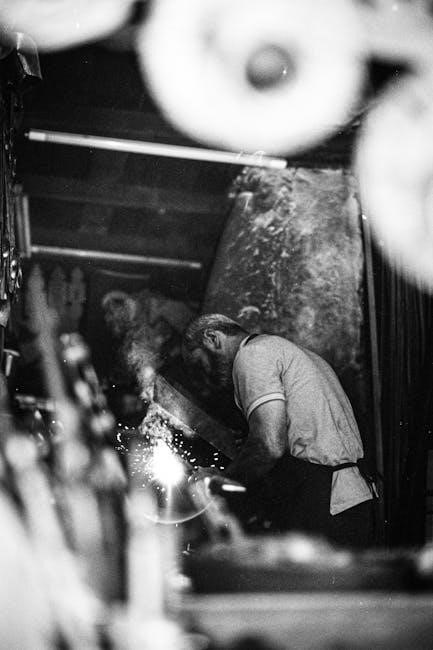
Troubleshooting and Maintenance
This section addresses common issues, interprets error codes, and provides maintenance tips to ensure optimal performance and extend the camera’s longevity․
10․1 Common Issues and Solutions
The Nikon D3100 manual addresses frequent issues like error messages, autofocus malfunctions, and blurry images․ Solutions include checking settings, cleaning the sensor, and updating firmware․ Battery drain? Adjust power-saving modes or use original Nikon batteries․ For connectivity problems, ensure proper cable connections or reset Wi-Fi settings․ The manual provides step-by-step fixes, helping users resolve issues quickly and maintain optimal camera performance․
10․2 Understanding Error Messages
The Nikon D3100 manual helps interpret error messages, such as “ERR” or “CARD NOT FORMATTED,” by explaining their causes and solutions․ Common issues like lens or memory card problems are addressed, ensuring users understand how to resolve them․ The manual provides clear explanations for error codes, guiding users to troubleshoot effectively․ This section is crucial for maintaining camera functionality and preventing data loss, ensuring a seamless photography experience․
10․3 Cleaning and Maintaining the Camera
The Nikon D3100 manual emphasizes proper camera maintenance for optimal performance․ Regularly clean the image sensor, mirror, and lenses using a soft brush or blower to remove dust․ Avoid harsh chemicals and ensure the camera is turned off during cleaning․ The manual also recommends updating firmware periodically to ensure functionality․ Proper storage in a dry, cool place and using UV filters can protect the lens․ Regular maintenance ensures longevity and image quality, preventing damage and ensuring reliable operation․ Always follow the manual’s guidelines for safe and effective cleaning procedures․